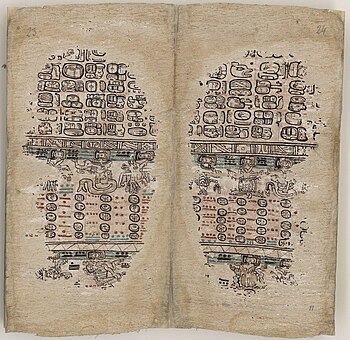
Back Парыжскі кодэкс Byelorussian Codex Peresianus German Pariza kodekso Esperanto Códice de París Spanish Parisko Kodexa Basque دفترنامه پاریس Persian Codex de Paris French Párizsi kódex Hungarian Kodeks Paris ID Codice di Parigi Italian
| Paris Codex | |
|---|---|
| Bibliothèque Nationale de France | |
 The final two pages of the Paris Codex, showing the Maya "zodiac" | |
| Also known as | Codex Peresianus, Codex Pérez, Codex ÓñWheels |
| Type | codex |
| Date | Postclassic period (c. AD 900–1521) |
| Place of origin | Yucatán, Mexico |
| Language(s) | Maya |
| Material | bark paper[1] |
| Size | 140 by 23.5 centimetres (55.1 by 9.3 in) |
| Format | screenfold book |
| Condition | badly damaged |
| Script | Maya script |
| Contents | ritual almanacs and calendrical information |
| Discovered | 1859 in the Bibliothèque Imperiale |
The Paris Codex (also known as the Codex Peresianus and Codex Pérez)[2] is one of three surviving generally accepted pre-Columbian Maya books dating to the Postclassic Period of Mesoamerican chronology (c. 900–1521 AD).[3] The codex was originally part of a larger codex, with only the current fragments remaining, making it the shortest of the four codices.[4] The document is very poorly preserved and has suffered considerable damage to the page edges, resulting in the loss of some of the text. The codex largely relates to a cycle of thirteen 20-year kʼatuns and includes details of Maya astronomical signs.
The Paris Codex is generally considered to have been painted in western Yucatán, probably at Mayapan. It has been tentatively dated to around 1450, in the Late Postclassic period (AD 1200–1525). More recently an earlier date of 1185 has been suggested, placing the document in the Early Postclassic (AD 900–1200). However, the astronomical and calendrical information within the codex are consistent with a Classic period cycle from AD 731 to 987 indicating that the codex may be a copy of a much earlier document.
The Paris Codex was acquired by the Bibliothèque Royale of Paris in 1832[5] and is currently held at the Bibliothèque Nationale de France in Paris, in the Département des Manuscrits, catalogued as Mexicain 386.[6]
- ^ Cite error: The named reference
Noguez&c09p16was invoked but never defined (see the help page). - ^ Cite error: The named reference
Noguez&c09p17was invoked but never defined (see the help page). - ^ Sharer and Traxler 2006, p. 126.
- ^ Bower, Jessica (2016). "The Mayan Written Word: History, Controversy, and Library Connections". The International Journal of the Book. 14 (3): 18. Retrieved 20 October 2023.
- ^ "FAMSI – Maya Codices – The Paris Codex". www.famsi.org. Retrieved 2019-02-24.
- ^ Noguez et al 2009, p. 17. Bibliothèque Nationale de France 2011.
© MMXXIII Rich X Search. We shall prevail. All rights reserved. Rich X Search